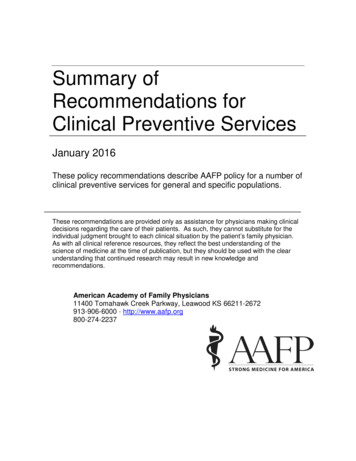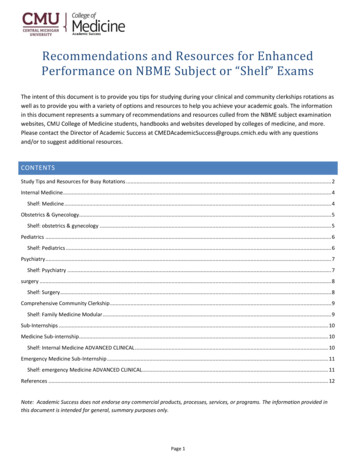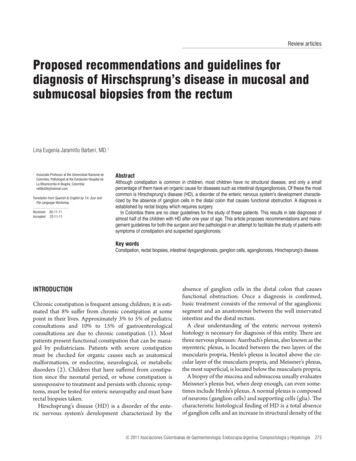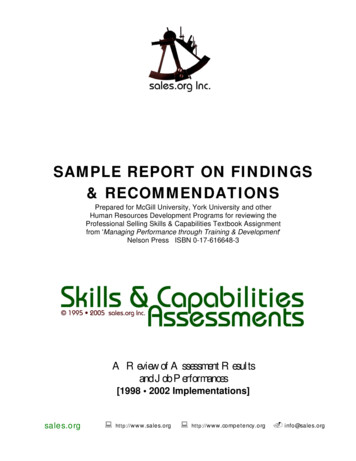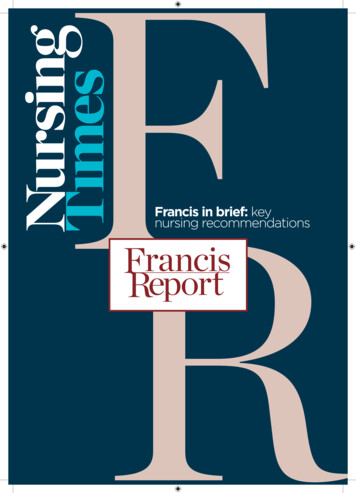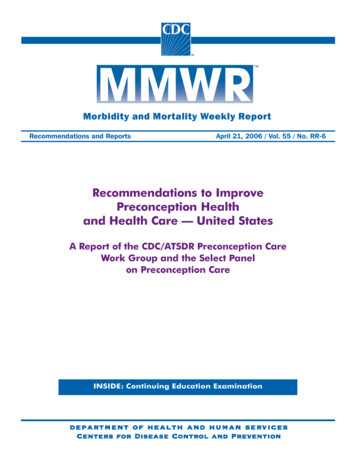
Transcription
Morbidity and Mortality Weekly ReportRecommendations and ReportsApril 21, 2006 / Vol. 55 / No. RR-6Recommendations to ImprovePreconception Healthand Health Care — United StatesA Report of the CDC/ATSDR Preconception CareWork Group and the Select Panelon Preconception CareINSIDE: Continuing Education Examinationdepartment of health and human servicesdepartmentservicesCenters for Disease Control and Prevention
MMWRThe MMWR series of publications is published by theCoordinating Center for Health Information and Service,Centers for Disease Control and Prevention (CDC), U.S.Department of Health and Human Services, Atlanta, GA 30333.CONTENTSIntroduction . 1Preconception Health and Care . 3Healthy People 2000/2010 ObjectivesSUGGESTED CITATIONCenters for Disease Control and Prevention.Recommendations to improve preconception healthand health care — United States: a report of the CDC/ATSDR Preconception Care Work Group and the SelectPanel on Preconception Care. MMWR 2006;55(No. RR6):[inclusive page numbers].Centers for Disease Control and Preventionfor Improving Preconception Healthand Guidelines for Preconception Care . 3Preconception Risks Associatedwith Adverse Pregnancy Outcomes . 4Preconception Prevention and Intervention . 6Context and Frame Work for Recommendations . 7How the Recommendations were Developed . 8Julie L. Gerberding, MD, MPHDirectorRecommendations to Improve Preconception Health . 8Dixie E. Snider, MD, MPHChief Science OfficerConclusion . 16Tanja Popovic, MD, PhDAssociate Director for ScienceAppendix . 22Coordinating Center for Health Informationand ServiceRecommendations . 9References . 16Continuing Education Activity . CE-1Steven L. Solomon, MDDirectorNational Center for Health MarketingJay M. Bernhardt, PhD, MPHDirectorDivision of Scientific CommunicationsJudith R. Aguilar(Acting) DirectorMary Lou Lindegren, MDEditor, MMWR SeriesSuzanne M. Hewitt, MPAManaging Editor, MMWR SeriesTeresa F. RutledgeLead Technical Writer-EditorPatricia A. McGeeProject EditorBeverly J. HollandLead Visual Information SpecialistLynda G. CupellMalbea A. LaPeteVisual Information SpecialistsQuang M. Doan, MBAErica R. ShaverInformation Technology SpecialistsDisclosure of RelationshipCDC, our planners, and our content experts wish to disclose theyhave no financial interests or other relationships with themanufacturers of commercial products, suppliers of commercialservices, or commercial supporters.
Vol. 55 / RR-6Recommendations and Reports1Recommendations to Improve Preconception Healthand Health Care — United StatesA Report of the CDC/ATSDR Preconception Care Work Groupand the Select Panel on Preconception CarePrepared byKay Johnson, MPH1, Samuel F. Posner, PhD2, Janis Biermann, MS3, José F. Cordero, MD4,Hani K. Atrash, MD4, Christopher S. Parker, PhD4, Sheree Boulet, DrPH4, Michele G. Curtis, MD51Dartmouth Hitchcock Medical Center, Lebanon, New Hampshire2Division of Reproductive Health, National Center for Chronic Disease Preventionand Health Promotion, CDC3March of Dimes, White Plains, New York4Office of the Director, National Center on Birth Defectsand Developmental Disabilities, CDC5American College of Obstetricians and Gynecologists, Washington, DCSummaryThis report provides recommendations to improve both preconception health and care. The goal of these recommendations is toimprove the health of women and couples, before conception of a first or subsequent pregnancy. Since the early 1990s, guidelineshave recommended preconception care, and reviews of previous studies have assessed the evidence for interventions and documented the evidence for specific interventions.CDC has developed these recommendations based on a review of published research and the opinions of specialists from theCDC/ATSDR Preconception Care Work Group and the Select Panel on Preconception Care. The 10 recommendations in thisreport are based on preconception health care for the U.S. population and are aimed at achieving four goals to 1) improve theknowledge and attitudes and behaviors of men and women related to preconception health; 2) assure that all women of childbearing age in the United States receive preconception care services (i.e., evidence-based risk screening, health promotion, andinterventions) that will enable them to enter pregnancy in optimal health; 3) reduce risks indicated by a previous adversepregnancy outcome through interventions during the interconception period, which can prevent or minimize health problems fora mother and her future children; and 4) reduce the disparities in adverse pregnancy outcomes.The recommendations focus on changes in consumer knowledge, clinical practice, public health programs, health-care financing, and data and research activities. Each recommendation is accompanied by a series of specific action steps and, whenimplemented, can yield results within 2–5 years. Based on implementation of the recommendations, improvements in access tocare, continuity of care, risk screening, appropriate delivery of interventions, and changes in health behaviors of men and womenof childbearing age are expected to occur. The implementation of these recommendations will help achieve Healthy People 2010objectives. The recommendations and action steps are a strategic plan that can be used by persons, communities, public healthand clinical providers, and governments to improve the health of women, their children, and their families. Improving preconception health among the approximately 62 million women of childbearing age will require multistrategic, action-orientedinitiatives.IntroductionThe material in this report originated in the National Center on BirthDefects and Developmental Disabilities, José F. Cordero, MD,Director; and the Office of Program Development, Hani K. Atrash,MD, Associate Director; and the National Center for Chronic DiseasePrevention and Health Promotion, Janet Collins, PhD, Director, andthe Division of Reproductive Health, John Lehnherr, Director.Corresponding preparer: Samuel F. Posner, PhD, Division ofReproductive Health, National Center for Chronic Disease Preventionand Health Promotion, 4770 Buford Hwy., NE, MS K-20, Atlanta,GA 30341. Telephone: 770-488-5200; Fax: 770-488-6450; E-mail:SPosner@cdc.gov.Improving preconception health can result in improved reproductive health outcomes, with potential for reducing societal costs as well (1–4). Preconception care aims to promotethe health of women of reproductive age before conceptionand thereby improve pregnancy-related outcomes (5–7).Therefore, the goals of the 10 recommendations in this report are to improve a woman’s health before conception,whether before a first or a subsequent pregnancy. The recommendations are 1) individual responsibility across the lifespan,2) consumer awareness, 3) preventive visits 4) interventions
2MMWRfor identified risks, 5) interconception care, 6) prepregnancycheckup, 7) health insurance coverage for women with lowincomes, 8) public health programs and strategies, 9) research,and 10) monitoring improvements.Since 1996, progress in the United States to improve pregnancy outcomes, including low birthweight, premature birth,and infant mortality has slowed, in part, because of inconsistent delivery and implementation of interventions before pregnancy to detect, treat, and help women modify behaviors,health conditions, and risk factors that contribute to adversematernal and infant outcomes (8). This report discusses several interventions that, if implemented before pregnancy, canimprove pregnancy outcomes for women and infants. However, millions of women and couples do not receive such interventions and services (8).Childbearing is a common experience among women inthe United States. In 2000, an estimated 62 million U.S.women were of childbearing age (aged 15–44 years), distributed in approximately equal segments across the age groupsof 15–24, 25–34, and 35–44 years (9). By age 25 years, approximately half of all women in the United States have experienced at least one birth, and approximately 85% of allwomen in the United States have given birth by age 44 years.In 2003, the fertility rate was 66 live births per 1,000 womenaged 15–44 years, with highest rates among women aged 25–29 years (114 per 1,000) and lowest rates among women aged 44 years (0.5 per 1,000). A similar age pattern has been observed within racial/ethnic populations, although women aged 25 years who are non-Hispanic black and Native Americanhad higher fertility rates than non-Hispanic whites and Asian/Pacific Islanders. Hispanic women have the highest fertilityrates overall and within each age group (10).In a 2004 survey of women aged 18–44 years, 84% had ahealth-care visit during the previous year, and slightly morethan half (55%) of women of reproductive age obtained preventive health services in any given year, which are opportunities to deliver preconception care (11). Becauseapproximately one third to half of women have more thanone primary care provider (i.e., generally a family physicianor internal medicine physician and an obstetrician/gynecologist) (12), all providers who routinely treat womenfor well-woman examinations or other routine visits play animportant role in improving preconception health. However,only approximately one of six obstetrician/gynecologists orfamily physicians had provided preconception care to themajority of the women for whom they provided prenatal care(13). Another study reported that mothers frequently interacted with pediatricians after the birth of one child and before conception of another, which affords another opportunityto promote preconception health care (14). Community healthApril 21, 2006centers and other Federally Qualified Health Centers(FQHC), including primary care and prenatal care, deliverservices to approximately 4.5 million women of childbearingage each year (15). These centers can be used to provide preconception care to women with low incomes (income 200%of the federal poverty level) and with no health insurance.This report provides recommendations to improve both preconception health and preconception health care. Several ofthe medical conditions, personal behaviors, psychosocial risks,and environmental exposures associated with negative pregnancyoutcomes can be identified and modified before conceptionthrough clinical interventions. For certain conditions, opportunities for preventive interventions occur only before conception. Establishing preconception health screening as part ofroutine care for women of reproductive age has been discussedin previously published reports (2,5,6,7,13,14). However better health care alone will not achieve optimal improvements inwomen’s preconception health and reproductive outcomes.Health promotion activities to modify personal knowledge andattitudes and behaviors related to reproductive risk factors andthe use of a reproductive life plan for women and couples alsohave been proposed (16,17). A reproductive health plan reflects a person’s intentions regarding the number and timing ofpregnancies in the context of their personal values and life goals.This health plan might increase the number of planned pregnancies and encourage persons to address risk behaviors beforeconception, reducing the risk for adverse outcomes for boththe mother and the infant.The recommendations should be used by consumers, clinical care providers, public health professionals, researchers,policy makers, and others concerned with the health ofwomen, children, and families. Federal, state, and local public health agencies can play a vital role in translating theserecommendations into projects, educational materials, andprograms designed to improve preconception health. Primarycare providers serving women of reproductive age, includingobstetrician/gynecologists, family physicians, nurse midwives,nurse practitioners, and others working in various clinicalsettings, have an equally critical role to play in implementingthese recommendations.CDC developed these recommendations by 1) reviewingpublished research; 2) convening the CDC/ASTDR Preconception Care Work Group, representing 22 programs; 3) evaluating presentations of best and emerging practice models atthe National Summit on Preconception Care in 2005; and 4)convening the Select Panel on Preconception Care (SPPC),comprised of subject matter specialists on obstetrics and gynecology, nursing, public health, midwifery, epidemiology,dentistry, family practice, pediatrics, and other disciplines.Various databases (e.g., PubMed [18]) were searched to iden-
Vol. 55 / RR-6Recommendations and Reportstify published studies for review. Search parameters includedpreconception care, birth outcomes, reproductive health, andwomen’s health. The reports were reviewed by the SPPC ofspecialists. These recommendations reflect the research, professional opinion, practice in medicine, public health, andrelated fields, which are sufficient to guide changes in program, practice, and policy. SPPC reviewed evidence to determine the effectiveness of certain interventions ofpreconception care (e.g., folic acid to prevent neural tubedefects and cessation of alcohol use) and identified missedopportunities for dissemination of preconception information. Implementation of these effective interventions can contribute to the health of thousands of women each year.These recommendations are a strategic plan to improvepreconception health through clinical care, individual behavior change, community-based public health programs, andsocial marketing campaigns to change consumer knowledgeand attitudes and practices. In addition, they are designed toincrease research knowledge related to preconception healthand care and to improve reproductive health outcomes for allwomen and couples. Policy changes at the local, state, andfederal levels will be necessary to support several of these recommendations. These policies will address changes in access,payment, and types of services available. Four goals were established for achieving these recommendations: 1) improvethe knowledge and attitudes and behaviors of men and womenrelated to preconception health; 2) assure that all women ofchildbearing age in the United States receive preconceptioncare services (i.e., evidence-based risk screening, health promotion, and interventions) that will enable them to enter pregnancy in optimal health; 3) reduce risks indicated by a previousadverse pregnancy outcome through interventions during theinterconception period, which can prevent or minimize healthproblems for a mother and her future children; and 4) reducethe disparities in adverse pregnancy outcomes.Preconception Health and CarePreconception care is recognized as a critical component ofhealth care for women of reproductive age (1–5,7,16,17,19–25). The main goal of preconception care is to provide healthpromotion, screening, and interventions for women of reproductive age to reduce risk factors that might affect futurepregnancies (7,16,22–25). Preconception care is part of a largerhealth-care model that results in healthier women, infants,and families (7,16,26–29).A substantial number of definitions for preconception carehave been used (2–5,16,19,30–33). On the basis of previousguidelines and recommendations, SPPC developed a refineddefinition for preconception care. Preconception care is de-3fined as a set of interventions that aim to identify and modifybiomedical, behavioral, and social risks to a woman’s healthor pregnancy outcome through prevention and management.Certain steps should be taken before conception or early inpregnancy to have a maximal effect on health outcomes. Preconception care is more than a single visit to a health-careprovider and less than all well-woman care, as defined by including the full scope of preventive and primary care servicesfor women before a first pregnancy or between pregnancies(i.e., commonly known as interconception care).Improving preconception health and pregnancy outcomeswill require more than effective clinical care for women.Changes in the knowledge and attitudes and behaviors related to reproductive health among both men and womenneed to be made to improve preconception health. Despiteseveral health promotion campaigns aimed at reducing smoking, misuse of alcohol, intimate partner violence, obesity,human immunodeficiency virus (HIV)/acquired immunodeficiency syndrome (AIDS), reduction of vaccine-preventablediseases, and exposure to occupational hazards, the majorityof U.S. adults are not aware of how these and other healthand lifestyle factors influence reproductive health and childbearing (34,35). Preconception health promotion, therefore,should focus on a general awareness among men and womenregarding reproductive health and risks to childbearing (26).Healthy People 2000/2010 Objectivesfor Improving Preconception Healthand Guidelines for Preconception CareA Healthy People 2000 objective (objective 14.3) is for 60%of primary care physicians to provide age-appropriate preconception care (36). This objective was deleted from HealthyPeople 2010 because it was not being measured. Although nospecific objective for preconception exists, several of thosespecified in Healthy People 2010 are relevant to preconception health (37,38).The Institute of Medicine, several national committees, anda substantial number of professional organizations have established guidelines and recommendations regarding the importance and content of preconception health care (1,3,4,30–33).The primary objective of these reports is to improve the healthof women, children, and families. The previously issuedevidence-based guidelines for preconception care have beensummarized and are the foundation for the recommendationsdeveloped by SPPC.The American Academy of Pediatrics (AAP) and the American College of Obstetricians and Gynecologists (ACOG) haveclassified the main components of preconception care intofour categories of interventions: physical assessment, risk
4MMWRscreening, vaccinations, and counseling. Eight areas of riskscreening are 1) reproductive awareness; 2) environmentaltoxins and teratogens; 3) nutrition and folic acid; 4) genetics;5) substance use, including tobacco and alcohol; 6) medicalconditions and medications; 7) infectious diseases and vaccination; and 8) psychosocial concerns (e.g., depression or violence) (3,24,26–31,33).Preconception care should be an essential part of primaryand preventive care, rather than an isolated visit (4,5,21–26,32,39,40). Whereas a prepregnancy planning visit in themonths before conception has been recommended (3,19,31),improving preconception health will require changes in theprocess of care, including the types of screening and riskreduction interventions offered to women of childbearing age.Guidelines for Perinatal Care, jointly issued by AAP andACOG, has recommended that all health encounters duringa woman’s reproductive years, particularly those that are apart of preconception care, should include counseling on appropriate medical care and behavior to optimize pregnancyoutcomes (41). Recommendations from these organizationsare analogous to the risk screening recommended by theAmerican Heart Association for cardiovascular disease (42).Several national organizations have recommended the routine delivery of preconception care. For example, the Marchof Dimes has recommended that the key physician/primarycare provider and the
Vol. 55 / RR-6 Recommendations and Reports 1 The material in this report originated in the National Center on Birth Defects and Developmental Disabilities, José F. Cordero, MD, Director; and the Office of Program D
